With its sweet, tart flavor and spicy edge, this ginger kombucha recipe is always a favorite. It's easy to make, and a great way to give a little life to your own homemade kombucha. It's easy to do, and similar in flavor to classic ginger beer - only with a decidedly tart finish.
Jump to Recipe | What is it? | Ingredients | How to Make It | Tips | Variations | Common Questions
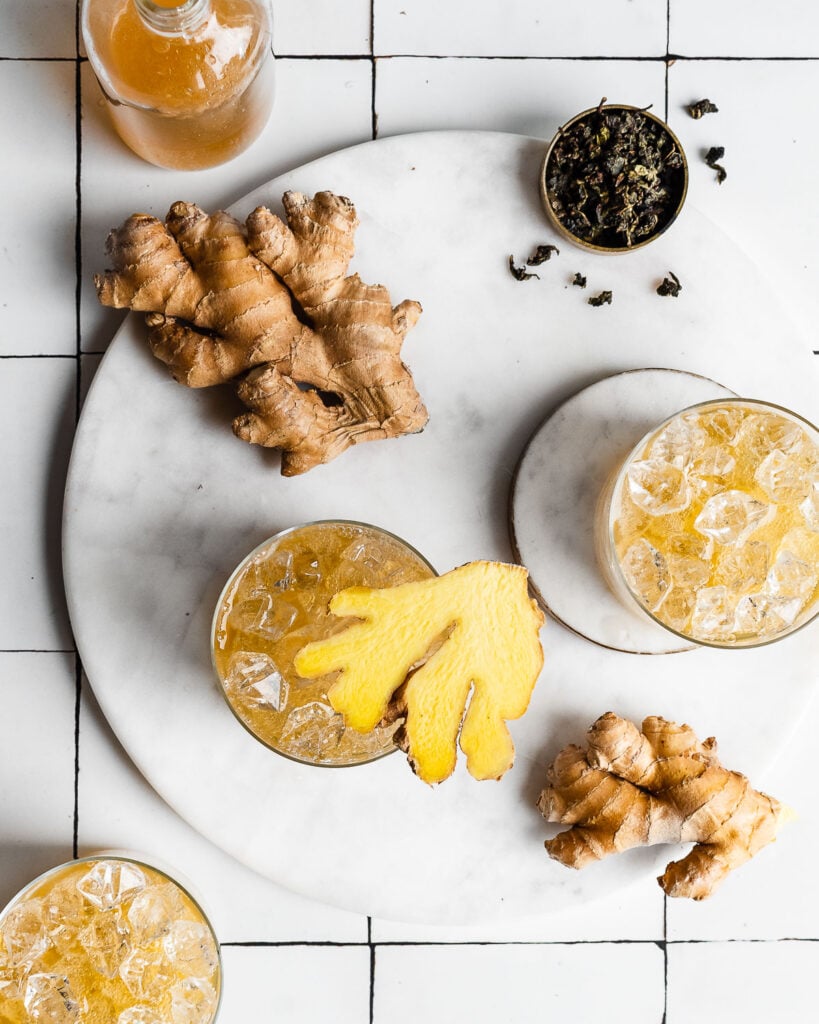
What is it?
Kombucha tea is a fermented drink made by culturing sweetened black tea with a symbiotic culture of bacteria and yeast. This symbiotic culture of bacteria and yeast is also known as a SCOBY or mother culture. The beneficial bacteria and yeast in the SCOBY convert the sugar in sweet tea into various b vitamins and acids, which produces the sweet-sour, vitamin-rich drink we know as kombucha.
Ginger kombucha is one of the most popular flavors, and you make it by flavoring kombucha tea with ginger root and a source of sweetener, such as honey, fruit juice, or sugar. The result is a fizzy probiotic beverage that has a gingery zip coupled with a pleasantly sweet, sour flavor reminiscent of apple cider vinegar and black tea.
Ingredients for Ginger Kombucha
In addition to prepared kombucha, which contains black tea and sugar, this version also uses ginger and honey. Both the ingredients and technique are simple.
- Prepare kombucha tea. You'll need tea from the first fermentation of kombucha, or plain kombucha tea without any additional flavorings. This forms the foundation of the recipe, and it contains plenty of live beneficial microbes that give kombucha its many health benefits (1).
- Fresh ginger. Look for fresh, organic ginger. Ginger is traditionally used to support digestion, ease nausea, and combat inflammation (2).
- Honey. Honey gives ginger kombucha a light sweetness with a delicate floral top note. Additionally, the good bacteria and wild yeast in the drink need a source of simple sugars in order to produce a fizzy brew.
How to Flavor Kombucha
There's a three-step process to making any flavored kombucha that you'll need to follow.
The initial or primary fermentation for kombucha is typically done in large jars using only black tea and sugar, as this keeps your SCOBY healthy and vibrant. Adding flavorings to the initial brew can compromise the culture's health and its ability to reproduce in the future, so you add flavorings during the second fermentation. Bottle conditioning, or transferring the brew to the fridge for a few days before drinking, is the final step and it helps make the kombucha fizzy.
- Initial fermentation. Brew your kombucha as you normally would using either the continuous brew or batch brew methods.
- Make the ginger syrup. Make the ginger syrup by simmering fresh ginger in hot water, and then stirring in honey until it dissolves. Once it cools to room temperature, it's time to strain the syrup.
- Secondary fermentation. Stir strained honey syrup into your plain kombucha, and then transfer it to glass bottles. Seal the bottles and let them ferment for up to three days at room temperature away from direct sunlight.
- Bottle conditioning. To set the bubbles, transfer the bottles of ginger kombucha to the fridge and let them age for at least two days to let the bubbles set. E
Recipe Tips
While brewing your own kombucha can seem complicated, the process is deceptively simple. If you can boil water or make tea, you can brew your own kombucha, too. With that in mind, there are a few tips you'll want to keep in mind.
- Use plain, homemade kombucha as your foundation. The kombucha you buy at stores has already been flavored and bottle conditioned, so it's best if you start with plain kombucha first.
- Make ginger syrup. While you could simply chop fresh ginger or add dried ginger to bottles of kombucha, you'll get the best flavor and less sediment by preparing a syrup first and adding the flavored syrup to your brew.
- Stir your homemade kombucha well before you flavor and bottle it. The live cultures in your brew have different weights, with bacteria floating and yeast sinking. So, to get the most balanced brew you can, make sure to stir the kombucha very well before you add your ginger syrup. Stirring distributes the live cultures, meaning you get uniformly fizzy bottles of booch.
- Use flip-top bottles because they have strong walls and tight-fitting lids. These bottles are intended for home brewing and you'll have better results using them.
- Temperature matters. Your ginger kombucha will ferment faster in hot temperatures and more slowly in a cold kitchen.
- If you're concerned about safety, test your brew with PH strips. For safety, your brew should be 4.5 or under on the PH scale. Most properly prepared kombucha will test between 2.5 and 3.5 on the scale.
- Let it sit in the fridge for a few days. This helps to set the bubbles, meaning a better fizz for you.
- Open your kombucha over the sink. Homebrewed booch can be super fizzy, and sometimes explosive. Opening it over the sink will keep your kitchen cleaner.
Variations
Add lemon. For a lemon-ginger kombucha recipe, add the juice of 1 lemon to the ginger syrup before stirring it into the kombucha for the second fermentation.
Try orange juice. Use only ½ cup ginger syrup, and then add ¼ cup orange juice and 1 teaspoon vanilla extract.
Make apple-ginger kombucha instead. Use only ½ cup ginger syrup, and then add ¼ cup apple juice or soft apple cider instead.
Make a green-tea option instead. Ginger works well with both green tea and honey, so you can use jun tea in place of kombucha for a lighter flavor (and less caffeine).
Try adding berries. Ginger is a delicious partner for both blueberries and raspberries. So try mashing ¼ cup of mixed berries into the ginger syrup while it's still hot. Once the syrup cools to room temperature, strain it all through a fine-mesh sieve and then add it to your kombucha for the secondary fermentation cycle.
Try adding peaches. Like berries, peaches are a natural match for ginger. Dice 1 peach and then mash it with the ginger syrup while it's still hot. Once cool, strain the ginger-peach mash and then add the syrup to your kombucha.
Add other spices to the mix such as coriander, cinnamon, or star anise. These will release their deep aromatic notes into the honey syrup, and ultimately into your booch, too.
Add mint. Mint is also good for the digestive system and it's a delicious addition to any ginger kombucha recipe.
Common Questions
You will need to make your own kombucha using a SCOBY. This is called the initial fermentation, and you can use the continuous brew method or the batch-brew method.
Homemade kombucha will last for up to 3 months in the fridge. Remember that cold temperatures slow, but do not completely halt, the fermentation process so your brew may grow increasingly sour with storage.
I recommend chopping fresh ginger into ¼-inch dice. If you're using organic ginger, you can keep the skin on as long as it's free from dirt and other debris. Some people prefer to grate the ginger using a microplane instead.
You can order a kombucha SCOBY (also called a mother or mushroom) online here.
When kombucha ferments, the bacteria and yeast release carbon dioxide. A sealed jar or bottle will trap the carbon dioxide, leaving no place for it to escape. As a result, the kombucha will become fizzy.
Use fresh ginger for your kombucha when you can. It's generally affordable and easy to find in most grocery stores and natural foods stores If you can't find fresh ginger, try dried cut and sifted ginger, but avoid ginger powder.
Ginger powder can leave your kombucha with thick, sticky sediment that's difficult to clean out of the bottom of the bottle.
Yes, you can mix ginger juice with a little bit of honey or other caloric sweetener and use that to flavor your kombucha. For many people, this is the easiest way though the flavor may be lighter.
If you want fizzy kombucha, you'll need to seal the bottle (or jar) tightly so that the carbon dioxide that builds up during fermentation can't escape. The best approach is to use high-quality, thick-walled bottles with flip-top lids that clamp easily.
If you don't wish to purchase them, you can use any other bottle or jar with a tight-fitting lid, keeping in mind that it's a less effective solution long-term.
While kombucha tea is traditionally fermented with black tea and sugar, you can use honey in the second fermentation or bottling conditioning phase since the honey doesn't come in contact with the SCOBY or mother.
Additionally, some styles of kombucha, such as Jun, are brewed using green tea and honey.
Try these fermented drinks next
References
- Júnior, Jayme César da Silva et al. “Kombucha: Formulation, chemical composition, and therapeutic potentialities.” Current research in food science vol. 5 360-365. 4 Feb. 2022
- Anh, Nguyen Hoang et al. “Ginger on Human Health: A Comprehensive Systematic Review of 109 Randomized Controlled Trials.” Nutrients vol. 12,1 157. 6 Jan. 2020

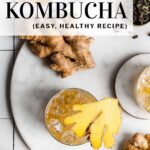
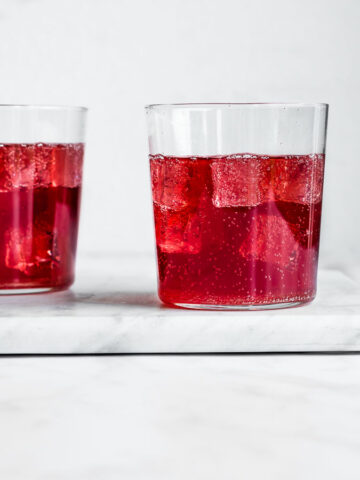
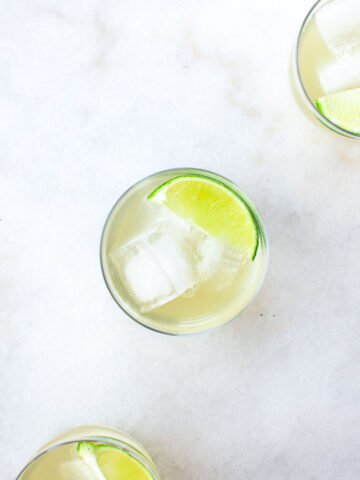
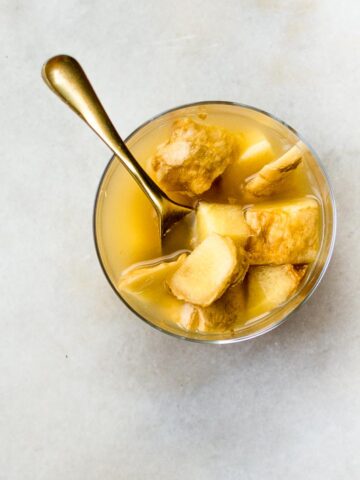
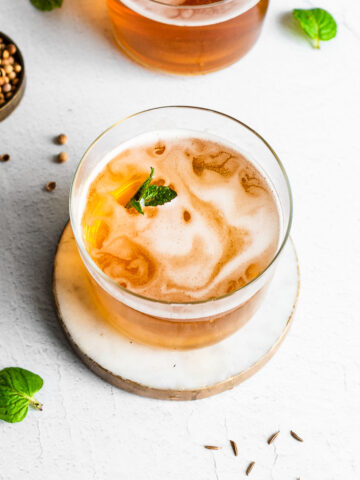
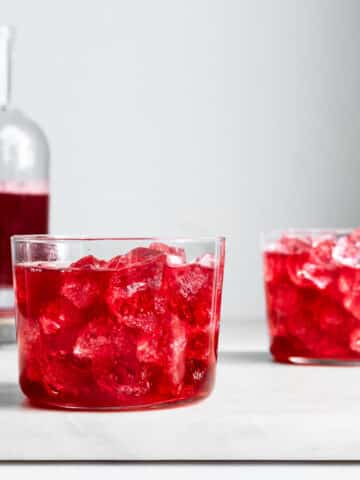
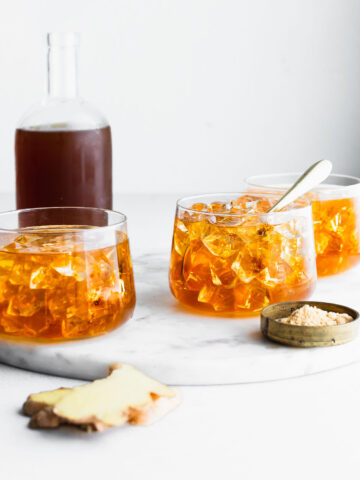
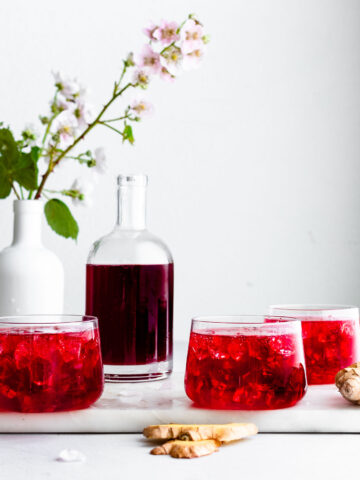
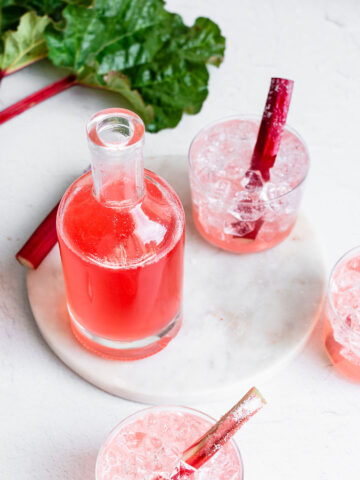
Kendy says
I had added dragon fruit to my Kambucha. At the end of 3rd day .. v happy with the results.. rich beautiful’berry’ colour. But have try yet .. let it ferment further.
Flo says
Hi Jenny,
I've been following you for a few months now and I just wanted to say how impressed I am with your knowledge and ease of information sharing. You are a breath of fresh air for new ideas in all areas, as you truly study what you put out there, instead of looking information up and "winging it" for posts on a blog etc.
I really appreciate your site - it gives me the nudge to get back to some of the simple, healthy things I used to make regularly, but have put on a back burner.
Thank you, Flo
Jenny McGruther says
Thank you so much for your thoughtful words, Flo.
4waystoyummy says
I am making a new batch of Kombucha today! While I often add ginger, I have not tried honey. I think those two ingredients marry so well. I always do a second ferment but I often use my failed jellies that are too runny for spreading ad the sweetener. I’ll try this today! Thank you.